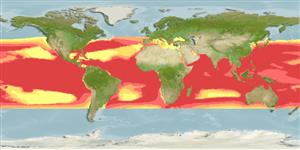Preferred temperature (Ref.
115969): 19.2 - 29, mean 27.1 (based on 6320 cells).
Índice de diversidade filogenética (Ref.
82804): PD
50 = 0.7500 [Uniqueness, from 0.5 = low to 2.0 = high].
Bayesian length-weight: a=0.01096 (0.00596 - 0.02017), b=2.91 (2.75 - 3.07), in cm Total Length, based on LWR estimates for this species & (Sub)family-body (Ref.
93245).
Nível Trófico (Ref.
69278): 4.5 ±0.0 se; based on diet studies.
Resiliência (Ref.
120179): Baixo, tempo mínimo de duplicação da população 4,5 - 14 anos (tm=7; tmax=20; K=0.088; Fec=2-4).
Prior r = 0.23, 95% CL = 0.15 - 0.34, Based on 1 data-limited stock assessment.
Fishing Vulnerability (Ref.
59153): Very high vulnerability (85 of 100).
Climate Vulnerability (Ref.
125649): High vulnerability (63 of 100).
